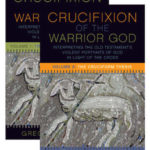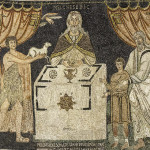We run our website the way we wished the whole internet worked: we provide high quality original content with no ads. We are funded solely by your direct support. Please consider supporting this project.

How Job’s Suffering Points to Jesus
As I introduced in my previous post, when we read the book of Job we must refute the common assumption that Yahweh is a Machiavellian deity who is controlling all that transpires in his creation, including Job’s suffering. At the same time, we must ask why the prologue (1:11-2, 2:3) and perhaps the final chapter (42:11) attributes Job’s suffering to Yahweh? We could explain this by appealing to the metonymy of the subject and perhaps to the other exegetical and historical-critical. This alone should suffice for those who make these verses the lynchpin for their interpretation of the book of Job and argue that this book highlights the unfathomable sovereign activity of God.
Nevertheless, for our purposes, the more important point concerns the theological significance of this dual way of depicting Yahweh. And this, I contend, is disclosed when we discern the way this dual depiction anticipates the dual reality of the cross, on which God took responsibility for all the afflictions he allowed and entered into full solidarity with all afflicters by becoming our sin while remaining sinless, and thereby appearing guilty for what he merely allowed. Since this event fully reveals God’s invariant character, and since God “breathed” his written witness primarily to bear witness to this event, we ought not find it surprising when God does the same thing in Job and throughout the canon. While God acted on the author of Job to “breath” magnificent truths about our vast ignorance of the unfathomably complex and war-torn creation we find ourselves in, God nevertheless stooped, as much as was necessary, to allow this author’s culturally-conditioned understanding of God to act on him and therefore to become on a literary level the responsible agent who afflicted Job—despite the fact that the rest of the narrative God “breathed” through this author confirms that he was not.
In addition, there is one more aspect of a crucicentric interpretation of Job that should be noted. The dual speech pattern found in this work takes on additional poignancy when we consider the manner in which Job’s afflictions function as a harbinger of Jesus’ suffering. Jesus asked his Father to let the cup of suffering he was about to drink pass from him “if it is possible” (Mt 26:39). It was not possible, however, for, among other things, there was simply no other way for the Father to vindicate his character to the world in the face of Satan’s age-long character assault on him that began in the garden except by allowing Satan to afflict his innocent Son (Gen 3:1-5). So too, within the context of this epic tale, it was simply not possible for God to vindicate his character before the heavenly court (and the audience) in the face of Satan’s character assault except by allowing his innocent servant Job to suffer at Satan’s hands.
Yet, just as the Father assumed responsibility for his Son’s suffering by allowing himself to be described as doing what merely allowed (Isa 53:4, 10), so too Yahweh assumed responsibility for the suffering of his servant Job by accommodating the ANE understanding of this author, thus allowing himself to be at several points identified as the agent who was responsible for his suffering, even though he was not. So too, just as Yahweh used Jesus’ suffering to defeat Satan on the cross, he used Job’s suffering to defeat Satan’s character assault on Job. And finally, just as the Father vindicated Jesus and honored him for his suffering by raising him from the dead and restoring him to his place of honor at this right hand, so Yahweh vindicated Job and restored him to a position of honor by restoring his fortune (Phil 2:8-9; Job 42:10-6). Our cross-centered reading of Job thus discerns that Job is a type of Christ in terms of why he suffered, the way God assumed responsibility for his suffering, the way God used his suffering to end a cosmic battle, and the way God vindicated Jesus after his sufferings.
Photo credit: Leo Reynolds via Visual hunt / CC BY-NC-SA
Category: General
Tags: Book of Job, Cruciform Theology, Suffering
Topics: Interpreting Violent Pictures and Troubling Behaviors
Related Reading

How do you explain the violent judgement of Ananias and Sapphira?
Question: You talk a lot about the violent depictions of God in the Old Testament. But what about God’s slaying of Ananias and Sapphira in the New? How do you explain that? Answer: The same way I explain divine violence in the Old Testament. There’s simply no reason to think the cruciform hermeneutic (reading Scripture…

God Became What He is Not To Reveal What He Is
We are saved because Jesus became the curse of the law for us (Gal. 3:13). So too, the way Christ freed us from the condemnation of sin and enabled us to “become the righteousness of God” was by becoming sin for us (2 Cor. 5:21). What is more, since the curse of the law includes enslavement to…

Podcast: How Do We Understand the Flood Through the Lens of the Cross?
Greg dives deep into the flood, to make sense of it through the lens of Christ on the cross. http://traffic.libsyn.com/askgregboyd/Episode_0087.mp3

Endorsements for Crucifixion of the Warrior God
Greg has gotten some really great endorsements for his upcoming Crucifixion of the Warrior God, so we thought we’d share them with all of you. If you want to learn more, you can go here. Enjoy! “We now have a plenitude of studies preoccupied with the vexed question of the violence of God in the Bible.…

What’s the Purpose of the Old Testament Law?
Whereas the old covenant was rooted in the law, the new covenant is rooted in simple faith, such as Abraham had. Whereas the old covenant was forged with one particular nation, the new covenant is available to all who are willing to accept it, regardless of their ethnicity and nationality. Whereas forgiveness of sins within…

